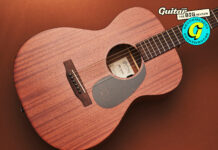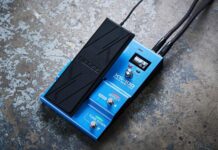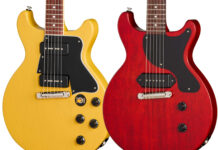
Essential Blues Pt. 6: Combining Basic Rhythm and Lead
In Lesson Five we discussed the Minor Pentatonic Scale in it’s first shape. This scale will be used to start forming our lead guitar lines.
A Minor Pentatonic:
Using notes from that scale, today we are going to look at some 12 bar blues rhythms and combine some simple lead lines with our rhythmic patterns that we have learnt over the last few lessons.
If we cast our minds back to lesson two and refresh on the second shuffle pattern:
We will be taking this shuffle pattern and adding some simple embellishments from the minor pentatonic scale to incorporate some lead guitar style playing. This will not instantly make you sound like a blues hero, but it will start to get your fingers moving and will serve as a fantastic starting point for your lead guitar skills to develop.
Here is the pattern in full. I will break this down into 4 bar segments so we can look at what is going on each step of the way:
Bars 1 – 4
In the first bar, we are sticking to our shuffle rhythm to get our groove locked in. This is played as it was in the lesson which covered blues shuffles, “1 a 2 a 3 a 4 a”.
In the second bar we stick with the same rhythmic feel, but the last 2 notes are now substituted by a D and C note (7th and 5th fret on the G string). This is the first embellishment. It locks into the rhythm of the piece but adds a melodic touch.
The third bar retains a similar feel to the first bar, except the final 2 notes (On the “4 a”) go from the 7th fret of the D string up to the 5th fret of the G.
The final bar ends with a descending 4 note run starting on the 5th fret of the D string on the “a 4 + a”.
Bars 5 – 8
In bar five we play the IV chord shuffle over the D chord as normal.
In the sixth bar we start to go up the pentatonic scale from the fourth beat playing the 8th fret of the B string and the 5th fret of the B string on the “4 a” beats.
In bars seven and eight we can see the end phrases start to form into some patterns which we might then recognise as being typical of playing lead guitar. Both phrases follow the timing of “a 4 + a” but both use the pentatonic notes in a different order.
Bars 9 – 12
In the ninth bar we move up to the V chord (This is E in the key of A minor) and this phrase ends with a 4 note descending run on the “a 4 + a”. The descending run starts on the 9th fret and runs back to the 7th and 5th frets. This position shift may be a little tricky at first. Take your time to make sure you’re hitting the notes clean.
Then back to the IV chord over the tenth bar but now ending with another descending run from the 8th fret of the B string also over the “a 4 + a” beats of the bar. You will want to reach up to the 8th fret with your little finger if possible to make the jump up from the 5th fret of the G a little easier.
The final two bars are back on the I chord as expected with a 12 bar cycle, the eleventh bar is just the straight shuffle rhythm and the final bar ends with a longer, ascending run up the scale. This final run encompasses 2 full beats and rhythmically fits into “3 + a 4 + a”. This is a tricky run to get started with as you want the rhythm of the 12 bar to be undisrupted. Immediately after ending on the 8th fret of the B string you would be back on your 1 beat of the first bar and the cycle repeats.
Try It Yourself
If, by now, you have tried out some of the shuffle rhythms in other keys you will find this lesson is also transposable around the guitar. The added notes here are not a “set in stone” method for learning lead guitar, but I think they will certainly help your fingers start to move and it will also allow you to see how important rhythmic aspects of lead guitar can be when playing blues. If you feel particularly adventurous, try to substitute the added notes for notes of your own choice from the Pentatonic scale.
If you have enjoyed this lesson and you’re looking for a guitar teacher in your local area check out our guitar lessons page and speak to one of our highly recommended teachers in your local area. If you are interested in speaking to one of our expect teachers via Skype check out our Skype Guitar Lessons website.
————————————–About the Author
Leigh Fuge is a guitar teacher and professional musician from Swansea in the UK. He has taught hundreds of students face to face and via the MGR Music platform. He has over 10 years’ experience working in the industry as a touring musician, session guitarist and teacher.The post Essential Blues Pt. 6: Combining Basic Rhythm and Lead appeared first on The Guitar Magazine.
Source: www.guitar-bass.net











